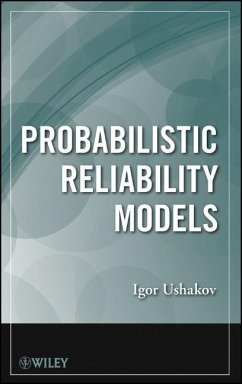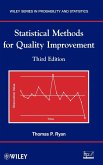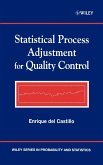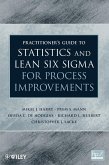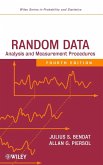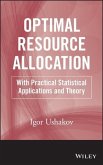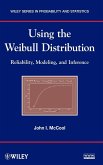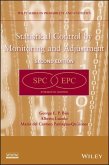Igor A. Ushakov
Probabilistic Reliability Models
Igor A. Ushakov
Probabilistic Reliability Models
- Gebundenes Buch
- Merkliste
- Auf die Merkliste
- Bewerten Bewerten
- Teilen
- Produkt teilen
- Produkterinnerung
- Produkterinnerung
Practical Approaches to Reliability Theory in Cutting-Edge Applications
Probabilistic Reliability Models helps readers understand and properly use statistical methods
and optimal resource allocation to solve engineering problems.
The author supplies engineers with a deeper understanding of mathematical models while also
equipping mathematically oriented readers with a fundamental knowledge of the engineeringrelated
applications at the center of model building. The book showcases the use of probability
theory and mathematical statistics to solve common, real-world reliability…mehr
Andere Kunden interessierten sich auch für
![Quality Improvement 3E Quality Improvement 3E]() Thomas P. RyanQuality Improvement 3E199,99 €
Thomas P. RyanQuality Improvement 3E199,99 €![Statistical Process Adjustment for Quality Control Statistical Process Adjustment for Quality Control]() Enrique Del CastilloStatistical Process Adjustment for Quality Control235,99 €
Enrique Del CastilloStatistical Process Adjustment for Quality Control235,99 €![Practitioner's Guide to Statistics and Lean Six SIGMA for Process Improvements Practitioner's Guide to Statistics and Lean Six SIGMA for Process Improvements]() Mikel HarryPractitioner's Guide to Statistics and Lean Six SIGMA for Process Improvements205,99 €
Mikel HarryPractitioner's Guide to Statistics and Lean Six SIGMA for Process Improvements205,99 €![Random Data Random Data]() Julius S. BendatRandom Data209,99 €
Julius S. BendatRandom Data209,99 €![Optimal Resource Allocation Optimal Resource Allocation]() Igor A. UshakovOptimal Resource Allocation119,99 €
Igor A. UshakovOptimal Resource Allocation119,99 €![Using the Weibull Distribution Using the Weibull Distribution]() John I. McCoolUsing the Weibull Distribution149,99 €
John I. McCoolUsing the Weibull Distribution149,99 €![Statistical Control by Monitoring and Adjustment Statistical Control by Monitoring and Adjustment]() George E P BoxStatistical Control by Monitoring and Adjustment157,99 €
George E P BoxStatistical Control by Monitoring and Adjustment157,99 €-
-
-
Practical Approaches to Reliability Theory in Cutting-Edge Applications
Probabilistic Reliability Models helps readers understand and properly use statistical methods
and optimal resource allocation to solve engineering problems.
The author supplies engineers with a deeper understanding of mathematical models while also
equipping mathematically oriented readers with a fundamental knowledge of the engineeringrelated
applications at the center of model building. The book showcases the use of probability
theory and mathematical statistics to solve common, real-world reliability problems. Following
an introduction to the topic, subsequent chapters explore key systems and models including:
Unrecoverable objects and recoverable systems
Methods of direct enumeration
Markov models and heuristic models
Performance effectiveness
Time redundancy
System survivability
Aging units and their related systems
Multistate systems
Detailed case studies illustrate the relevance of the discussed methods to real-world technical
projects including software failure avalanches, gas pipelines with underground storage, and
intercontinental ballistic missile (ICBM) control systems. Numerical examples and detailed
explanations accompany each topic, and exercises throughout allow readers to test their
comprehension of the presented material.
Probabilistic Reliability Models is an excellent book for statistics, engineering, and operations
research courses on applied probability at the upper-undergraduate and graduate levels. The
book is also a valuable reference for professionals and researchers working in industry who
would like a mathematical review of reliability models and the relevant applications.
Hinweis: Dieser Artikel kann nur an eine deutsche Lieferadresse ausgeliefert werden.
Probabilistic Reliability Models helps readers understand and properly use statistical methods
and optimal resource allocation to solve engineering problems.
The author supplies engineers with a deeper understanding of mathematical models while also
equipping mathematically oriented readers with a fundamental knowledge of the engineeringrelated
applications at the center of model building. The book showcases the use of probability
theory and mathematical statistics to solve common, real-world reliability problems. Following
an introduction to the topic, subsequent chapters explore key systems and models including:
Unrecoverable objects and recoverable systems
Methods of direct enumeration
Markov models and heuristic models
Performance effectiveness
Time redundancy
System survivability
Aging units and their related systems
Multistate systems
Detailed case studies illustrate the relevance of the discussed methods to real-world technical
projects including software failure avalanches, gas pipelines with underground storage, and
intercontinental ballistic missile (ICBM) control systems. Numerical examples and detailed
explanations accompany each topic, and exercises throughout allow readers to test their
comprehension of the presented material.
Probabilistic Reliability Models is an excellent book for statistics, engineering, and operations
research courses on applied probability at the upper-undergraduate and graduate levels. The
book is also a valuable reference for professionals and researchers working in industry who
would like a mathematical review of reliability models and the relevant applications.
Hinweis: Dieser Artikel kann nur an eine deutsche Lieferadresse ausgeliefert werden.
Produktdetails
- Produktdetails
- Verlag: Wiley & Sons
- 1. Auflage
- Seitenzahl: 248
- Erscheinungstermin: 9. Oktober 2012
- Englisch
- Abmessung: 236mm x 163mm x 23mm
- Gewicht: 544g
- ISBN-13: 9781118341834
- ISBN-10: 111834183X
- Artikelnr.: 35456202
- Herstellerkennzeichnung
- Libri GmbH
- Europaallee 1
- 36244 Bad Hersfeld
- gpsr@libri.de
- Verlag: Wiley & Sons
- 1. Auflage
- Seitenzahl: 248
- Erscheinungstermin: 9. Oktober 2012
- Englisch
- Abmessung: 236mm x 163mm x 23mm
- Gewicht: 544g
- ISBN-13: 9781118341834
- ISBN-10: 111834183X
- Artikelnr.: 35456202
- Herstellerkennzeichnung
- Libri GmbH
- Europaallee 1
- 36244 Bad Hersfeld
- gpsr@libri.de
IGOR USHAKOV, PhD, is Senior Consultant at Advanced Logistics Developments in Tel Aviv, Israel. He has published extensively in his areas of research interest, which include operations research, applied statistics, and probabilistic modeling. Dr. Ushakov is the author of Handbook of Reliability Engineering as well as the coauthor of Probabilistic Reliability Engineering and Statistical Reliability Engineering, all published by Wiley.
Preface xiii
Acronyms and Notations xv
1 What Is Reliability? 1
1.1 Reliability as a Property of Technical Objects, 1
1.2 Other "Ilities", 2
1.3 Hierarchical Levels of Analyzed Objects, 5
1.4 How Can Reliability Be Measured?, 5
1.5 Software Reliability, 7
1.5.1 Case Study: Avalanche of Software Failures, 8
2 Unrecoverable Objects 9
2.1 Unit, 9
2.1.1 Probability of Failure-Free Operation, 9
2.1.2 Mean Time to Failure, 10
2.2 Series Systems, 11
2.2.1 Probability of Failure-Free Operation, 11
2.2.2 Mean Time to Failure, 13
2.3 Parallel System, 14
2.3.1 Probability of Failure-Free Operation, 14
2.3.2 Mean Time to Failure, 18
2.4 Structure of Type "k-out-of-n", 20
2.5 Realistic Models of Loaded Redundancy, 22
2.5.1 Unreliable Switching Process, 23
2.5.2 Non-Instant Switching, 23
2.5.3 Unreliable Switch, 24
2.5.4 Switch Serving as Interface, 25
2.5.5 Incomplete Monitoring of the Operating Unit, 26
2.5.6 Periodical Monitoring of the Operating Unit, 28
2.6 Reducible Structures, 28
2.6.1 Parallel-Series and Series-Parallel Structures, 28
2.6.2 General Case of Reducible Structures, 29
2.7 Standby Redundancy, 30
2.7.1 Simple Redundant Group, 30
2.7.2 Standby Redundancy of Type "k-out-of-n", 33
2.8 Realistic Models of Unloaded Redundancy, 34
2.8.1 Unreliable Switching Process, 34
2.8.2 Non-Instant Switching, 35
2.8.3 Unreliable Switch, 35
2.8.4 Switch Serving as Interface, 37
2.8.5 Incomplete Monitoring of the Operating Unit, 38
3 Recoverable Systems: Markov Models 40
3.1 Unit, 40
3.1.1 Markov Model, 41
3.2 Series System, 47
3.2.1 Turning Off System During Recovery, 47
3.2.2 System in Operating State During Recovery: Unrestricted Repair, 49
3.2.3 System in Operating State During Recovery: Restricted Repair, 51
3.3 Dubbed System, 53
3.3.1 General Description, 53
3.3.2 Nonstationary Availability Coefficient, 54
3.3.3 Stationary Availability Coefficient, 58
3.3.4 Probability of Failure-Free Operation, 59
3.3.5 Stationary Coefficient of Interval Availability, 62
3.3.6 Mean Time to Failure, 63
3.3.7 Mean Time Between Failures, 63
3.3.8 Mean Recovery Time, 65
3.4 Parallel Systems, 65
3.5 Structures of Type "m-out-of-n", 66
4 Recoverable Systems: Heuristic Models 72
4.1 Preliminary Notes, 72
4.2 Poisson Process, 75
4.3 Procedures over Poisson Processes, 78
4.3.1 Thinning Procedure, 78
4.3.2 Superposition Procedure, 80
4.4 Asymptotic Thinning Procedure over Stochastic Point Process, 80
4.5 Asymptotic Superposition of Stochastic Point Processes, 82
4.6 Intersection of Flows of Narrow Impulses, 84
4.7 Heuristic Method for Reliability Analysis of Series Recoverable
Systems, 87
4.8 Heuristic Method for Reliability Analysis of Parallel Recoverable
Systems, 87
4.8.1 Influence of Unreliable Switching Procedure, 88
4.8.2 Influence of Switch's Unreliability, 89
4.8.3 Periodical Monitoring of the Operating Unit, 90
4.8.4 Partial Monitoring of the Operating Unit, 91
4.9 Brief Historical Overview and Related Sources, 93
5 Time Redundancy 95
5.1 System with Possibility of Restarting Operation, 95
5.2 Systems with "Admissibly Short Failures", 98
5.3 Systems with Time Accumulation, 99
5.4 Case Study: Gas Pipeline with an Underground Storage, 100
5.5 Brief Historical Overview and Related Sources, 102
6 "Aging" Units and Systems of "Aging" Units 103
6.1 Chebyshev Bound, 103
6.2 "Aging" Unit, 104
6.3 Bounds for Probability of Failure-Free Operations, 105
6.4 Series System Consisting of "Aging" Units, 108
6.4.1 Preliminary Lemma, 108
6.5 Series System, 110
6.5.1 Probability of Failure-Free Operation, 110
6.5.2 Mean Time to Failure of a Series System, 112
6.6 Parallel System, 114
6.6.1 Probability of Failure-Free Operation, 114
6.6.2 Mean Time to Failure, 117
6.7 Bounds for the Coefficient of Operational Availability, 119
6.8 Brief Historical Overview and Related Sources, 121
7 Two-Pole Networks 123
7.1 General Comments, 123
7.1.1 Method of Direct Enumeration, 125
7.2 Method of Boolean Function Decomposition, 127
7.3 Method of Paths and Cuts, 130
7.3.1 Esary-Proschan Bounds, 130
7.3.2 "Improvements" of Esary-Proschan Bounds, 133
7.3.3 Litvak-Ushakov Bounds, 135
7.3.4 Comparison of the Two Methods, 139
7.4 Brief Historical Overview and Related Sources, 140
8 Performance Effectiveness 143
8.1 Effectiveness Concepts, 143
8.2 General Idea of Effectiveness Evaluation, 145
8.2.1 Conditional Case Study: Airport Traffic Control System, 147
8.3 Additive Type of System Units' Outcomes, 150
8.4 Case Study: ICBM Control System, 151
8.5 Systems with Intersecting Zones of Action, 153
8.6 Practical Recommendation, 158
8.7 Brief Historical Overview and Related Sources, 160
9 System Survivability 162
9.1 Illustrative Example, 166
9.2 Brief Historical Overview and Related Sources, 167
10 Multistate Systems 169
10.1 Preliminary Notes, 169
10.2 Generating Function, 169
10.3 Universal Generating Function, 172
10.4 Multistate Series System, 174
10.4.1 Series Connection of Piping Runs, 174
10.4.2 Series Connection of Resistors, 177
10.4.3 Series Connections of Capacitors, 179
10.5 Multistate Parallel System, 181
10.5.1 Parallel Connection of Piping Runs, 181
10.5.2 Parallel Connection of Resistors, 182
10.5.3 Parallel Connections of Capacitors, 182
10.6 Reducible Systems, 183
10.7 Conclusion, 190
10.8 Brief Historical Overview and Related Sources, 190
Appendix A Main Distributions Related to Reliability Theory 195
A.1 Discrete Distributions, 195
A.1.1 Degenerate Distribution, 195
A.1.2 Bernoulli Distribution, 196
A.1.3 Binomial Distribution, 197
A.1.4 Poisson Distribution, 198
A.1.5 Geometric Distribution, 200
A.2 Continuous Distributions, 201
A.2.1 Intensity Function, 201
A.2.2 Continuous Uniform Distribution, 202
A.2.3 Exponential Distribution, 203
A.2.4 Erlang Distribution, 204
A.2.5 Hyperexponential Distribution, 205
A.2.6 Normal Distribution, 207
A.2.7Weibull-Gnedenko Distribution, 207
Appendix B Laplace Transformation 209
Appendix C Markov Processes 214
C.1 General Markov Process, 214
C.1.1 Nonstationary Availability Coefficient, 216
C.1.2 Probability of Failure-Free Operation, 218
C.1.3 Stationary Availability Coefficient, 220
C.1.4 Mean Time to Failure and Mean Time Between Failures, 221
C.1.5 Mean Recovery Time, 222
C.2 Birth-Death Process, 223
Appendix D General Bibliography 227
Index 231
Acronyms and Notations xv
1 What Is Reliability? 1
1.1 Reliability as a Property of Technical Objects, 1
1.2 Other "Ilities", 2
1.3 Hierarchical Levels of Analyzed Objects, 5
1.4 How Can Reliability Be Measured?, 5
1.5 Software Reliability, 7
1.5.1 Case Study: Avalanche of Software Failures, 8
2 Unrecoverable Objects 9
2.1 Unit, 9
2.1.1 Probability of Failure-Free Operation, 9
2.1.2 Mean Time to Failure, 10
2.2 Series Systems, 11
2.2.1 Probability of Failure-Free Operation, 11
2.2.2 Mean Time to Failure, 13
2.3 Parallel System, 14
2.3.1 Probability of Failure-Free Operation, 14
2.3.2 Mean Time to Failure, 18
2.4 Structure of Type "k-out-of-n", 20
2.5 Realistic Models of Loaded Redundancy, 22
2.5.1 Unreliable Switching Process, 23
2.5.2 Non-Instant Switching, 23
2.5.3 Unreliable Switch, 24
2.5.4 Switch Serving as Interface, 25
2.5.5 Incomplete Monitoring of the Operating Unit, 26
2.5.6 Periodical Monitoring of the Operating Unit, 28
2.6 Reducible Structures, 28
2.6.1 Parallel-Series and Series-Parallel Structures, 28
2.6.2 General Case of Reducible Structures, 29
2.7 Standby Redundancy, 30
2.7.1 Simple Redundant Group, 30
2.7.2 Standby Redundancy of Type "k-out-of-n", 33
2.8 Realistic Models of Unloaded Redundancy, 34
2.8.1 Unreliable Switching Process, 34
2.8.2 Non-Instant Switching, 35
2.8.3 Unreliable Switch, 35
2.8.4 Switch Serving as Interface, 37
2.8.5 Incomplete Monitoring of the Operating Unit, 38
3 Recoverable Systems: Markov Models 40
3.1 Unit, 40
3.1.1 Markov Model, 41
3.2 Series System, 47
3.2.1 Turning Off System During Recovery, 47
3.2.2 System in Operating State During Recovery: Unrestricted Repair, 49
3.2.3 System in Operating State During Recovery: Restricted Repair, 51
3.3 Dubbed System, 53
3.3.1 General Description, 53
3.3.2 Nonstationary Availability Coefficient, 54
3.3.3 Stationary Availability Coefficient, 58
3.3.4 Probability of Failure-Free Operation, 59
3.3.5 Stationary Coefficient of Interval Availability, 62
3.3.6 Mean Time to Failure, 63
3.3.7 Mean Time Between Failures, 63
3.3.8 Mean Recovery Time, 65
3.4 Parallel Systems, 65
3.5 Structures of Type "m-out-of-n", 66
4 Recoverable Systems: Heuristic Models 72
4.1 Preliminary Notes, 72
4.2 Poisson Process, 75
4.3 Procedures over Poisson Processes, 78
4.3.1 Thinning Procedure, 78
4.3.2 Superposition Procedure, 80
4.4 Asymptotic Thinning Procedure over Stochastic Point Process, 80
4.5 Asymptotic Superposition of Stochastic Point Processes, 82
4.6 Intersection of Flows of Narrow Impulses, 84
4.7 Heuristic Method for Reliability Analysis of Series Recoverable
Systems, 87
4.8 Heuristic Method for Reliability Analysis of Parallel Recoverable
Systems, 87
4.8.1 Influence of Unreliable Switching Procedure, 88
4.8.2 Influence of Switch's Unreliability, 89
4.8.3 Periodical Monitoring of the Operating Unit, 90
4.8.4 Partial Monitoring of the Operating Unit, 91
4.9 Brief Historical Overview and Related Sources, 93
5 Time Redundancy 95
5.1 System with Possibility of Restarting Operation, 95
5.2 Systems with "Admissibly Short Failures", 98
5.3 Systems with Time Accumulation, 99
5.4 Case Study: Gas Pipeline with an Underground Storage, 100
5.5 Brief Historical Overview and Related Sources, 102
6 "Aging" Units and Systems of "Aging" Units 103
6.1 Chebyshev Bound, 103
6.2 "Aging" Unit, 104
6.3 Bounds for Probability of Failure-Free Operations, 105
6.4 Series System Consisting of "Aging" Units, 108
6.4.1 Preliminary Lemma, 108
6.5 Series System, 110
6.5.1 Probability of Failure-Free Operation, 110
6.5.2 Mean Time to Failure of a Series System, 112
6.6 Parallel System, 114
6.6.1 Probability of Failure-Free Operation, 114
6.6.2 Mean Time to Failure, 117
6.7 Bounds for the Coefficient of Operational Availability, 119
6.8 Brief Historical Overview and Related Sources, 121
7 Two-Pole Networks 123
7.1 General Comments, 123
7.1.1 Method of Direct Enumeration, 125
7.2 Method of Boolean Function Decomposition, 127
7.3 Method of Paths and Cuts, 130
7.3.1 Esary-Proschan Bounds, 130
7.3.2 "Improvements" of Esary-Proschan Bounds, 133
7.3.3 Litvak-Ushakov Bounds, 135
7.3.4 Comparison of the Two Methods, 139
7.4 Brief Historical Overview and Related Sources, 140
8 Performance Effectiveness 143
8.1 Effectiveness Concepts, 143
8.2 General Idea of Effectiveness Evaluation, 145
8.2.1 Conditional Case Study: Airport Traffic Control System, 147
8.3 Additive Type of System Units' Outcomes, 150
8.4 Case Study: ICBM Control System, 151
8.5 Systems with Intersecting Zones of Action, 153
8.6 Practical Recommendation, 158
8.7 Brief Historical Overview and Related Sources, 160
9 System Survivability 162
9.1 Illustrative Example, 166
9.2 Brief Historical Overview and Related Sources, 167
10 Multistate Systems 169
10.1 Preliminary Notes, 169
10.2 Generating Function, 169
10.3 Universal Generating Function, 172
10.4 Multistate Series System, 174
10.4.1 Series Connection of Piping Runs, 174
10.4.2 Series Connection of Resistors, 177
10.4.3 Series Connections of Capacitors, 179
10.5 Multistate Parallel System, 181
10.5.1 Parallel Connection of Piping Runs, 181
10.5.2 Parallel Connection of Resistors, 182
10.5.3 Parallel Connections of Capacitors, 182
10.6 Reducible Systems, 183
10.7 Conclusion, 190
10.8 Brief Historical Overview and Related Sources, 190
Appendix A Main Distributions Related to Reliability Theory 195
A.1 Discrete Distributions, 195
A.1.1 Degenerate Distribution, 195
A.1.2 Bernoulli Distribution, 196
A.1.3 Binomial Distribution, 197
A.1.4 Poisson Distribution, 198
A.1.5 Geometric Distribution, 200
A.2 Continuous Distributions, 201
A.2.1 Intensity Function, 201
A.2.2 Continuous Uniform Distribution, 202
A.2.3 Exponential Distribution, 203
A.2.4 Erlang Distribution, 204
A.2.5 Hyperexponential Distribution, 205
A.2.6 Normal Distribution, 207
A.2.7Weibull-Gnedenko Distribution, 207
Appendix B Laplace Transformation 209
Appendix C Markov Processes 214
C.1 General Markov Process, 214
C.1.1 Nonstationary Availability Coefficient, 216
C.1.2 Probability of Failure-Free Operation, 218
C.1.3 Stationary Availability Coefficient, 220
C.1.4 Mean Time to Failure and Mean Time Between Failures, 221
C.1.5 Mean Recovery Time, 222
C.2 Birth-Death Process, 223
Appendix D General Bibliography 227
Index 231
Preface xiii
Acronyms and Notations xv
1 What Is Reliability? 1
1.1 Reliability as a Property of Technical Objects, 1
1.2 Other "Ilities", 2
1.3 Hierarchical Levels of Analyzed Objects, 5
1.4 How Can Reliability Be Measured?, 5
1.5 Software Reliability, 7
1.5.1 Case Study: Avalanche of Software Failures, 8
2 Unrecoverable Objects 9
2.1 Unit, 9
2.1.1 Probability of Failure-Free Operation, 9
2.1.2 Mean Time to Failure, 10
2.2 Series Systems, 11
2.2.1 Probability of Failure-Free Operation, 11
2.2.2 Mean Time to Failure, 13
2.3 Parallel System, 14
2.3.1 Probability of Failure-Free Operation, 14
2.3.2 Mean Time to Failure, 18
2.4 Structure of Type "k-out-of-n", 20
2.5 Realistic Models of Loaded Redundancy, 22
2.5.1 Unreliable Switching Process, 23
2.5.2 Non-Instant Switching, 23
2.5.3 Unreliable Switch, 24
2.5.4 Switch Serving as Interface, 25
2.5.5 Incomplete Monitoring of the Operating Unit, 26
2.5.6 Periodical Monitoring of the Operating Unit, 28
2.6 Reducible Structures, 28
2.6.1 Parallel-Series and Series-Parallel Structures, 28
2.6.2 General Case of Reducible Structures, 29
2.7 Standby Redundancy, 30
2.7.1 Simple Redundant Group, 30
2.7.2 Standby Redundancy of Type "k-out-of-n", 33
2.8 Realistic Models of Unloaded Redundancy, 34
2.8.1 Unreliable Switching Process, 34
2.8.2 Non-Instant Switching, 35
2.8.3 Unreliable Switch, 35
2.8.4 Switch Serving as Interface, 37
2.8.5 Incomplete Monitoring of the Operating Unit, 38
3 Recoverable Systems: Markov Models 40
3.1 Unit, 40
3.1.1 Markov Model, 41
3.2 Series System, 47
3.2.1 Turning Off System During Recovery, 47
3.2.2 System in Operating State During Recovery: Unrestricted Repair, 49
3.2.3 System in Operating State During Recovery: Restricted Repair, 51
3.3 Dubbed System, 53
3.3.1 General Description, 53
3.3.2 Nonstationary Availability Coefficient, 54
3.3.3 Stationary Availability Coefficient, 58
3.3.4 Probability of Failure-Free Operation, 59
3.3.5 Stationary Coefficient of Interval Availability, 62
3.3.6 Mean Time to Failure, 63
3.3.7 Mean Time Between Failures, 63
3.3.8 Mean Recovery Time, 65
3.4 Parallel Systems, 65
3.5 Structures of Type "m-out-of-n", 66
4 Recoverable Systems: Heuristic Models 72
4.1 Preliminary Notes, 72
4.2 Poisson Process, 75
4.3 Procedures over Poisson Processes, 78
4.3.1 Thinning Procedure, 78
4.3.2 Superposition Procedure, 80
4.4 Asymptotic Thinning Procedure over Stochastic Point Process, 80
4.5 Asymptotic Superposition of Stochastic Point Processes, 82
4.6 Intersection of Flows of Narrow Impulses, 84
4.7 Heuristic Method for Reliability Analysis of Series Recoverable
Systems, 87
4.8 Heuristic Method for Reliability Analysis of Parallel Recoverable
Systems, 87
4.8.1 Influence of Unreliable Switching Procedure, 88
4.8.2 Influence of Switch's Unreliability, 89
4.8.3 Periodical Monitoring of the Operating Unit, 90
4.8.4 Partial Monitoring of the Operating Unit, 91
4.9 Brief Historical Overview and Related Sources, 93
5 Time Redundancy 95
5.1 System with Possibility of Restarting Operation, 95
5.2 Systems with "Admissibly Short Failures", 98
5.3 Systems with Time Accumulation, 99
5.4 Case Study: Gas Pipeline with an Underground Storage, 100
5.5 Brief Historical Overview and Related Sources, 102
6 "Aging" Units and Systems of "Aging" Units 103
6.1 Chebyshev Bound, 103
6.2 "Aging" Unit, 104
6.3 Bounds for Probability of Failure-Free Operations, 105
6.4 Series System Consisting of "Aging" Units, 108
6.4.1 Preliminary Lemma, 108
6.5 Series System, 110
6.5.1 Probability of Failure-Free Operation, 110
6.5.2 Mean Time to Failure of a Series System, 112
6.6 Parallel System, 114
6.6.1 Probability of Failure-Free Operation, 114
6.6.2 Mean Time to Failure, 117
6.7 Bounds for the Coefficient of Operational Availability, 119
6.8 Brief Historical Overview and Related Sources, 121
7 Two-Pole Networks 123
7.1 General Comments, 123
7.1.1 Method of Direct Enumeration, 125
7.2 Method of Boolean Function Decomposition, 127
7.3 Method of Paths and Cuts, 130
7.3.1 Esary-Proschan Bounds, 130
7.3.2 "Improvements" of Esary-Proschan Bounds, 133
7.3.3 Litvak-Ushakov Bounds, 135
7.3.4 Comparison of the Two Methods, 139
7.4 Brief Historical Overview and Related Sources, 140
8 Performance Effectiveness 143
8.1 Effectiveness Concepts, 143
8.2 General Idea of Effectiveness Evaluation, 145
8.2.1 Conditional Case Study: Airport Traffic Control System, 147
8.3 Additive Type of System Units' Outcomes, 150
8.4 Case Study: ICBM Control System, 151
8.5 Systems with Intersecting Zones of Action, 153
8.6 Practical Recommendation, 158
8.7 Brief Historical Overview and Related Sources, 160
9 System Survivability 162
9.1 Illustrative Example, 166
9.2 Brief Historical Overview and Related Sources, 167
10 Multistate Systems 169
10.1 Preliminary Notes, 169
10.2 Generating Function, 169
10.3 Universal Generating Function, 172
10.4 Multistate Series System, 174
10.4.1 Series Connection of Piping Runs, 174
10.4.2 Series Connection of Resistors, 177
10.4.3 Series Connections of Capacitors, 179
10.5 Multistate Parallel System, 181
10.5.1 Parallel Connection of Piping Runs, 181
10.5.2 Parallel Connection of Resistors, 182
10.5.3 Parallel Connections of Capacitors, 182
10.6 Reducible Systems, 183
10.7 Conclusion, 190
10.8 Brief Historical Overview and Related Sources, 190
Appendix A Main Distributions Related to Reliability Theory 195
A.1 Discrete Distributions, 195
A.1.1 Degenerate Distribution, 195
A.1.2 Bernoulli Distribution, 196
A.1.3 Binomial Distribution, 197
A.1.4 Poisson Distribution, 198
A.1.5 Geometric Distribution, 200
A.2 Continuous Distributions, 201
A.2.1 Intensity Function, 201
A.2.2 Continuous Uniform Distribution, 202
A.2.3 Exponential Distribution, 203
A.2.4 Erlang Distribution, 204
A.2.5 Hyperexponential Distribution, 205
A.2.6 Normal Distribution, 207
A.2.7Weibull-Gnedenko Distribution, 207
Appendix B Laplace Transformation 209
Appendix C Markov Processes 214
C.1 General Markov Process, 214
C.1.1 Nonstationary Availability Coefficient, 216
C.1.2 Probability of Failure-Free Operation, 218
C.1.3 Stationary Availability Coefficient, 220
C.1.4 Mean Time to Failure and Mean Time Between Failures, 221
C.1.5 Mean Recovery Time, 222
C.2 Birth-Death Process, 223
Appendix D General Bibliography 227
Index 231
Acronyms and Notations xv
1 What Is Reliability? 1
1.1 Reliability as a Property of Technical Objects, 1
1.2 Other "Ilities", 2
1.3 Hierarchical Levels of Analyzed Objects, 5
1.4 How Can Reliability Be Measured?, 5
1.5 Software Reliability, 7
1.5.1 Case Study: Avalanche of Software Failures, 8
2 Unrecoverable Objects 9
2.1 Unit, 9
2.1.1 Probability of Failure-Free Operation, 9
2.1.2 Mean Time to Failure, 10
2.2 Series Systems, 11
2.2.1 Probability of Failure-Free Operation, 11
2.2.2 Mean Time to Failure, 13
2.3 Parallel System, 14
2.3.1 Probability of Failure-Free Operation, 14
2.3.2 Mean Time to Failure, 18
2.4 Structure of Type "k-out-of-n", 20
2.5 Realistic Models of Loaded Redundancy, 22
2.5.1 Unreliable Switching Process, 23
2.5.2 Non-Instant Switching, 23
2.5.3 Unreliable Switch, 24
2.5.4 Switch Serving as Interface, 25
2.5.5 Incomplete Monitoring of the Operating Unit, 26
2.5.6 Periodical Monitoring of the Operating Unit, 28
2.6 Reducible Structures, 28
2.6.1 Parallel-Series and Series-Parallel Structures, 28
2.6.2 General Case of Reducible Structures, 29
2.7 Standby Redundancy, 30
2.7.1 Simple Redundant Group, 30
2.7.2 Standby Redundancy of Type "k-out-of-n", 33
2.8 Realistic Models of Unloaded Redundancy, 34
2.8.1 Unreliable Switching Process, 34
2.8.2 Non-Instant Switching, 35
2.8.3 Unreliable Switch, 35
2.8.4 Switch Serving as Interface, 37
2.8.5 Incomplete Monitoring of the Operating Unit, 38
3 Recoverable Systems: Markov Models 40
3.1 Unit, 40
3.1.1 Markov Model, 41
3.2 Series System, 47
3.2.1 Turning Off System During Recovery, 47
3.2.2 System in Operating State During Recovery: Unrestricted Repair, 49
3.2.3 System in Operating State During Recovery: Restricted Repair, 51
3.3 Dubbed System, 53
3.3.1 General Description, 53
3.3.2 Nonstationary Availability Coefficient, 54
3.3.3 Stationary Availability Coefficient, 58
3.3.4 Probability of Failure-Free Operation, 59
3.3.5 Stationary Coefficient of Interval Availability, 62
3.3.6 Mean Time to Failure, 63
3.3.7 Mean Time Between Failures, 63
3.3.8 Mean Recovery Time, 65
3.4 Parallel Systems, 65
3.5 Structures of Type "m-out-of-n", 66
4 Recoverable Systems: Heuristic Models 72
4.1 Preliminary Notes, 72
4.2 Poisson Process, 75
4.3 Procedures over Poisson Processes, 78
4.3.1 Thinning Procedure, 78
4.3.2 Superposition Procedure, 80
4.4 Asymptotic Thinning Procedure over Stochastic Point Process, 80
4.5 Asymptotic Superposition of Stochastic Point Processes, 82
4.6 Intersection of Flows of Narrow Impulses, 84
4.7 Heuristic Method for Reliability Analysis of Series Recoverable
Systems, 87
4.8 Heuristic Method for Reliability Analysis of Parallel Recoverable
Systems, 87
4.8.1 Influence of Unreliable Switching Procedure, 88
4.8.2 Influence of Switch's Unreliability, 89
4.8.3 Periodical Monitoring of the Operating Unit, 90
4.8.4 Partial Monitoring of the Operating Unit, 91
4.9 Brief Historical Overview and Related Sources, 93
5 Time Redundancy 95
5.1 System with Possibility of Restarting Operation, 95
5.2 Systems with "Admissibly Short Failures", 98
5.3 Systems with Time Accumulation, 99
5.4 Case Study: Gas Pipeline with an Underground Storage, 100
5.5 Brief Historical Overview and Related Sources, 102
6 "Aging" Units and Systems of "Aging" Units 103
6.1 Chebyshev Bound, 103
6.2 "Aging" Unit, 104
6.3 Bounds for Probability of Failure-Free Operations, 105
6.4 Series System Consisting of "Aging" Units, 108
6.4.1 Preliminary Lemma, 108
6.5 Series System, 110
6.5.1 Probability of Failure-Free Operation, 110
6.5.2 Mean Time to Failure of a Series System, 112
6.6 Parallel System, 114
6.6.1 Probability of Failure-Free Operation, 114
6.6.2 Mean Time to Failure, 117
6.7 Bounds for the Coefficient of Operational Availability, 119
6.8 Brief Historical Overview and Related Sources, 121
7 Two-Pole Networks 123
7.1 General Comments, 123
7.1.1 Method of Direct Enumeration, 125
7.2 Method of Boolean Function Decomposition, 127
7.3 Method of Paths and Cuts, 130
7.3.1 Esary-Proschan Bounds, 130
7.3.2 "Improvements" of Esary-Proschan Bounds, 133
7.3.3 Litvak-Ushakov Bounds, 135
7.3.4 Comparison of the Two Methods, 139
7.4 Brief Historical Overview and Related Sources, 140
8 Performance Effectiveness 143
8.1 Effectiveness Concepts, 143
8.2 General Idea of Effectiveness Evaluation, 145
8.2.1 Conditional Case Study: Airport Traffic Control System, 147
8.3 Additive Type of System Units' Outcomes, 150
8.4 Case Study: ICBM Control System, 151
8.5 Systems with Intersecting Zones of Action, 153
8.6 Practical Recommendation, 158
8.7 Brief Historical Overview and Related Sources, 160
9 System Survivability 162
9.1 Illustrative Example, 166
9.2 Brief Historical Overview and Related Sources, 167
10 Multistate Systems 169
10.1 Preliminary Notes, 169
10.2 Generating Function, 169
10.3 Universal Generating Function, 172
10.4 Multistate Series System, 174
10.4.1 Series Connection of Piping Runs, 174
10.4.2 Series Connection of Resistors, 177
10.4.3 Series Connections of Capacitors, 179
10.5 Multistate Parallel System, 181
10.5.1 Parallel Connection of Piping Runs, 181
10.5.2 Parallel Connection of Resistors, 182
10.5.3 Parallel Connections of Capacitors, 182
10.6 Reducible Systems, 183
10.7 Conclusion, 190
10.8 Brief Historical Overview and Related Sources, 190
Appendix A Main Distributions Related to Reliability Theory 195
A.1 Discrete Distributions, 195
A.1.1 Degenerate Distribution, 195
A.1.2 Bernoulli Distribution, 196
A.1.3 Binomial Distribution, 197
A.1.4 Poisson Distribution, 198
A.1.5 Geometric Distribution, 200
A.2 Continuous Distributions, 201
A.2.1 Intensity Function, 201
A.2.2 Continuous Uniform Distribution, 202
A.2.3 Exponential Distribution, 203
A.2.4 Erlang Distribution, 204
A.2.5 Hyperexponential Distribution, 205
A.2.6 Normal Distribution, 207
A.2.7Weibull-Gnedenko Distribution, 207
Appendix B Laplace Transformation 209
Appendix C Markov Processes 214
C.1 General Markov Process, 214
C.1.1 Nonstationary Availability Coefficient, 216
C.1.2 Probability of Failure-Free Operation, 218
C.1.3 Stationary Availability Coefficient, 220
C.1.4 Mean Time to Failure and Mean Time Between Failures, 221
C.1.5 Mean Recovery Time, 222
C.2 Birth-Death Process, 223
Appendix D General Bibliography 227
Index 231

